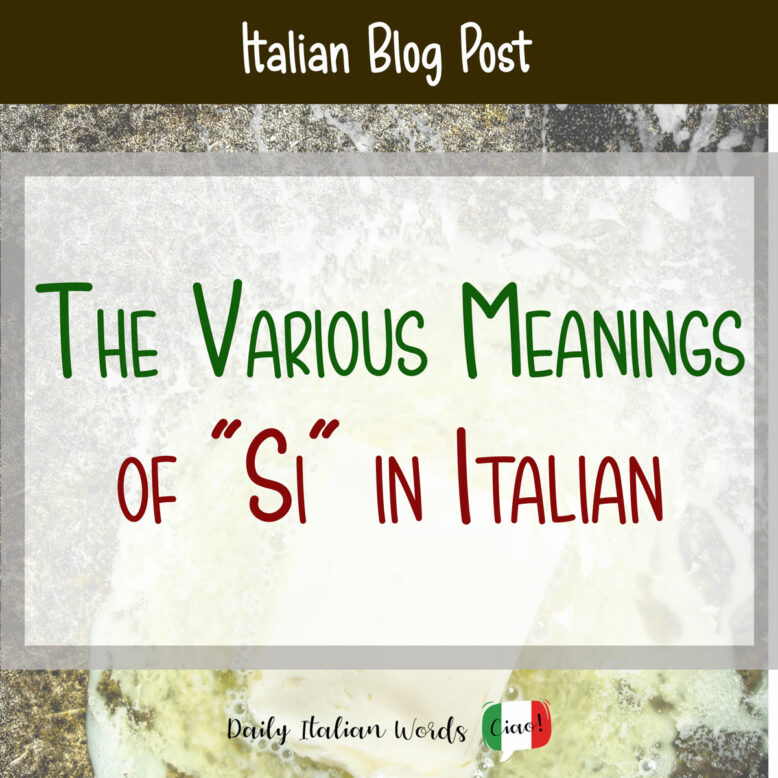Si: a tiny yet incredibly versatile word in Italian, one that’s capable of transforming itself to fulfil various roles within sentences.

Let’s consider, for example, this phrase:
Sì, Anna si sta ancora vestendo; sai che non si mette fretta ad una donna!
Yes, Anna is still getting dressed; you know you never rush a woman!
See how these two-letter word does it all, from affirming something, to creating reflexive verbs, and even orchestrating impersonal sentences? Let’s explore all these uses in more detail, shall we? Make sure to stick around till the end for a fun fact!
How to use ‘si’ in Italian
Si has 6 distinct uses and meanings, each playing a crucial role in expressing yourself fluently. Below, I’ll share everyday examples that will show you the many faces of si in Italian.
1. Sì = yes
First and foremost, sì with an accent on the i is our enthusiastic agreement word. When you want to confirm something or express agreement, you simply say sì with strong emphasis on the pronunciation.
Vuoi un caffè? Sì, grazie!
Would you like a coffee? Yes, please!
In this context, sì can also masquerade as a noun occasionally, though you’ll encounter this less frequently:
Accetto solo un sì come risposta!
I only accept a yes as an answer!
2. Sì = abbreviation of così
The accented sì in Italian can also be an abbreviation of the adverb così, meaning “this way”. While this usage is more archaic and not so common today, it’s a fascinating bit of Italian language history. One famous example of this comes from Dante’s Inferno, Canto XVII:
Sì cominciò lo mio duca a parlarmi.
So did my guide begin to speak to me.
You might not see this form much in modern Italian, but who knows? The next time you’re diving into a poem or an old text, you might just stumble upon it and get the chance to wow your friends and family!
3. Si = reflexive pronoun
Si without an accent mark serves as a reflexive pronoun. In this form, it reflects the action back onto the subject in the third person singular (himself, herself) and plural (themselves). It’s like seeing actions bounce back to the doer. Think of verbs like lavarsi (to wash yourself), vestirsi (to get dressed), alzarsi (to get up), or guardarsi (to look at oneself):
Siamo in ritardo, Elena si sta ancora vestendo.
We are late, Elena is still getting dressed.
4. Si = one, people (impersonal)
The unaccented si can also be used in impersonal constructions where actions are generalised without specifying a subject, similarly to English constructions like “One should…” or “It is necessary to…” . In this case, the verb is conjugated at the third person singular.
In Italia non si mangia la pizza con l’ananas.
In Italy people don’t eat pizza with pineapple.
Here, si makes the action seem universal, which is super handy when stating general truths or giving advice.
5. Si = pronominal particle in pronominal verbs
Si appears in many pronominal verbs in Italian. These verbs incorporate one or two pronouns to alter or enhance the meaning of the original verb. Si often combines with other particles like la and ne, transforming ‘i’ into ‘e’ and resulting in forms such as -sene or -sela:
Anna non dovrebbe prendersela ogni volta che le facciamo uno scherzo!
Anna shouldn’t take it personally every time we joke with her!
Here are examples of such verbs:
- andarsene (to leave), from andare (to go) + SI + NE
- occuparsene (to take care of something), from occupare (to occupy) + SI + NE
- aspettarsela (to expect), formed cavare (to remove) + SI + LA
- cercarsela (to ask for it), from cercare (to look for) + SI + LA
6. Si = B note
Si is also a musical note in Italian, precisely note number seven on the musical scale:
do-re-mi-fa-sol-la-si-do
C-D-E-F-G-A-B-C
Let’s wrap up with a fun fact: sì was also a famous type of moped produced by the iconic Italian brand Piaggio between the 1970s and the early 2000s. Check out this vintage advertisement!

Valentina Nicastro is a travel writer in love with her home country, Italy. Having travelled widely around the globe, she realised there was more to explore closer to home and decided to put the passport aside for a while. When she is not immersed in documenting Italy, you’ll find her donning her communication consultant hat, weaving words as a content writer and bridging linguistic divides as a translator.


